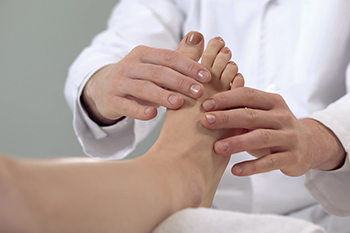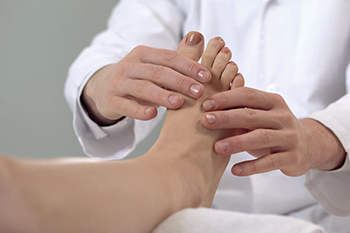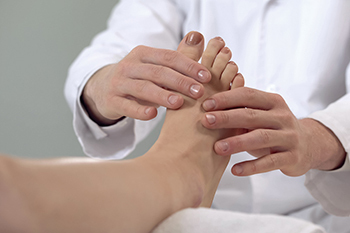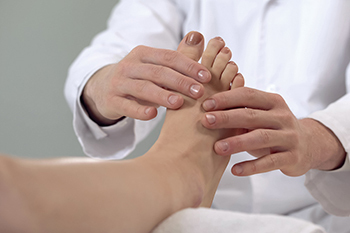September 2022
Contagious Athlete’s Foot

The foot condition known as athlete’s foot can be uncomfortable and many people are embarrassed at how their feet look when they are afflicted with this ailment. It is caused by a fungus that lives in warm and moist environments including shower room floors, public swimming pools, and locker rooms. The fungus can invade the body through small cracks in the skin on the feet and initial symptoms of athlete’s foot can consist of itchiness and redness. It is suggested to wear appropriate shoes while in these types of areas as this may help to control the spread of athlete's foot. It is a contagious foot condition, and it is suggested that towels, shoes, and socks should not be shared. The symptoms of untreated athlete’s foot may gradually worsen and if you suffer from this ailment, it is strongly suggested that you are under the care of a podiatrist who can offer you the correct treatment methods.
Athlete’s foot is an inconvenient condition that can be easily reduced with the proper treatment. If you have any concerns about your feet and ankles, contact Gregory T. Loo, DPM from Elite Podiatry. Our doctor will treat your foot and ankle needs.
Athlete’s Foot: The Sole Story
Athlete's foot, also known as tinea pedis, can be an extremely contagious foot infection. It is commonly contracted in public changing areas and bathrooms, dormitory style living quarters, around locker rooms and public swimming pools, or anywhere your feet often come into contact with other people.
Solutions to Combat Athlete’s Foot
- Hydrate your feet by using lotion
- Exfoliate
- Buff off nails
- Use of anti-fungal products
- Examine your feet and visit your doctor if any suspicious blisters or cuts develop
Athlete’s foot can cause many irritating symptoms such as dry and flaking skin, itching, and redness. Some more severe symptoms can include bleeding and cracked skin, intense itching and burning, and even pain when walking. In the worst cases, Athlete’s foot can cause blistering as well. Speak to your podiatrist for a better understanding of the different causes of Athlete’s foot, as well as help in determining which treatment options are best for you.
If you have any questions please feel free to contact one of our offices located in Ahwatukee, and Phoenix, AZ . We offer the newest diagnostic and treatment technologies for all your foot and ankle needs.
Diabetes and Heel Fissures

Cracked heels, or heel fissures, are cracks or splits in the skin on the soles of the feet, often going through to the inner layers of skin. They can be painful when pressure is applied to the skin while standing, and they can bleed. This condition generally comes from dry skin. Loss of nerve supply to the sweat glands in the feet can happen to diabetics, because they tend to have drier skin than others. Heel fissures are common in the general population, but those with diabetes can have more serious consequences if they do not deal with cracked heels effectively. Diabetics can also suffer from neuropathy, causing loss of feeling in the feet. With the loss of sensation, patients with diabetes can have fissures that bleed and can possibly become infected and ulcerated without knowing it. If you are a diabetic, make sure to visually inspect your feet regularly. If you have cracked heels or some other foot problem, it is important for you to see a podiatrist for prompt treatment.
Diabetic foot care is important in preventing foot ailments such as ulcers. If you are suffering from diabetes or have any other concerns about your feet, contact Gregory T. Loo, DPM from Elite Podiatry. Our doctor can provide the care you need to keep you pain-free and on your feet.
Diabetic Foot Care
Diabetes affects millions of people every year. The condition can damage blood vessels in many parts of the body, especially the feet. Because of this, taking care of your feet is essential if you have diabetes, and having a podiatrist help monitor your foot health is highly recommended.
The Importance of Caring for Your Feet
- Routinely inspect your feet for bruises or sores.
- Wear socks that fit your feet comfortably.
- Wear comfortable shoes that provide adequate support.
Patients with diabetes should have their doctor monitor their blood levels, as blood sugar levels play such a huge role in diabetic care. Monitoring these levels on a regular basis is highly advised.
It is always best to inform your healthcare professional of any concerns you may have regarding your feet, especially for diabetic patients. Early treatment and routine foot examinations are keys to maintaining proper health, especially because severe complications can arise if proper treatment is not applied.
If you have any questions please feel free to contact one of our offices located in Ahwatukee, and Phoenix, AZ . We offer the newest diagnostic and treatment technologies for all your foot and ankle needs.
Dealing With Corns on the Feet

Corns on the foot develop from friction, usually as a result of a toe rubbing against the inside of a shoe. A callus, or toughened skin, develops with a hardened kernel at its center, thus the name corn. Most corns can be treated with a series of foot care measures, but people with diabetes, poor circulation, or foot deformities are wise to seek immediate help from a podiatrist. The first and best defense against developing a corn is to wear shoes that fit properly and to wear socks that form a kind of cushion, lessening friction. A warm foot bath can help soften the callused area, and a pumice can help to reduce its size. Keeping the feet moisturized also can help prevent the formation of a corn. A number of types of foot pads are available to protect the toe from further friction. It is not wise to try to remove a corn yourself with any sharp object, as this may lead to an infection. If a corn does not go away or causes severe pain, it is a good idea to make an appointment with a podiatrist who can treat the problem safely.
Corns can make walking very painful and should be treated immediately. If you have questions regarding your feet and ankles, contact Gregory T. Loo, DPM of Elite Podiatry. Our doctor will treat your foot and ankle needs.
Corns: What Are They? And How Do You Get Rid of Them?
Corns are thickened areas on the skin that can become painful. They are caused by excessive pressure and friction on the skin. Corns press into the deeper layers of the skin and are usually round in shape.
Ways to Prevent Corns
There are many ways to get rid of painful corns such as:
- Wearing properly fitting shoes that have been measured by a professional
- Wearing shoes that are not sharply pointed or have high heels
- Wearing only shoes that offer support
Treating Corns
Although most corns slowly disappear when the friction or pressure stops, this isn’t always the case. Consult with your podiatrist to determine the best treatment option for your case of corns.
If you have any questions please feel free to contact one of our offices located in Ahwatukee, and Phoenix, AZ . We offer the newest diagnostic and treatment technologies for all your foot and ankle needs.
Are You Suffering From Ingrown Toenails?
Children's Feet are Different Than Adult's Feet

There are 26 bones in each foot, and they are designed in a complex way to support the body, absorb shock while walking and running, and conform to specific surfaces. When babies are born, their feet are mostly cartilage, which will harden into bones at approximately 13 years of age. The bones will develop gradually, and it is beneficial for them to wear shoes that fit properly when walking begins. Research has indicated the feet grow the fastest in the first three years, and may grow up to nine sizes during that time. Greater activity levels in children produce more stress in the feet than adults, and it is suggested that shoes which have extra cushioning be worn during the early years. Children’s shoes may show wear and tear faster than adult’s shoes, and this may be the result of excess sweating that occurs during physical activities. There are many choices to consider when purchasing children’s shoes, and it is advised that you speak with a podiatrist who can help you to make the right decision for your children’s feet.
Making sure that your children maintain good foot health is very important as they grow. If you have any questions, contact Gregory T. Loo, DPM of Elite Podiatry. Our doctor can provide the care you need to keep you pain-free and on your feet.
Keeping Children's Feet Healthy
Having healthy feet during childhood can help prevent medical problems later in life, namely in the back and legs. As children grow, their feet require different types of care. Here are some things to consider...
Although babies do not walk yet, it is still very important to take care of their feet.
Avoid putting tight shoes or socks on his or her feet.
Allow the baby to stretch and kick his or her feet to feel comfortable.
As a toddler, kids are now on the move and begin to develop differently. At this age, toddlers are getting a feel for walking, so don’t be alarmed if your toddler is unsteady or ‘walks funny’.
As your child gets older, it is important to teach them how to take care of their feet.
Show them proper hygiene to prevent infections such as fungus.
Be watchful for any pain or injury.
Have all injuries checked by a doctor as soon as possible.
Comfortable, protective shoes should always be worn, especially at play.
If you have any questions please feel free to contact one of our offices located in Ahwatukee, and Phoenix, AZ . We offer the newest diagnostic and treatment technologies for all your foot and ankle needs.










